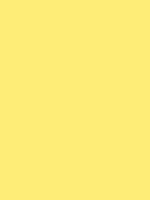#feed77 Color Information
In a RGB color space, hex #feed77 is composed of 99.6% red, 92.9% green and 46.7% blue. Whereas in a CMYK color space, it is composed of 0% cyan, 6.7% magenta, 53.1% yellow and 0.4% black. It has a hue angle of 52.4 degrees, a saturation of 98.5% and a lightness of 73.1%. #feed77 color hex could be obtained by blending #ffffee with #fddb00. Closest websafe color is: #ffff66.
-
- R 100
- G 93
- B 47
-
- C 0
- M 7
- Y 53
- K 0
● #feed77 color description : Soft yellow.
#feed77 Color Conversion
The hexadecimal color #feed77 has RGB values of R:254, G:237, B:119 and CMYK values of C:0, M:0.07, Y:0.53, K:0. Its decimal value is 16706935.
| Hex triplet | feed77 | #feed77 |
|---|---|---|
| RGB Decimal | 254, 237, 119 | rgb(254,237,119) |
| RGB Percent | 99.6, 92.9, 46.7 | rgb(99.6%,92.9%,46.7%) |
| CMYK | 0, 7, 53, 0 | |
| HSL | 52.4°, 98.5, 73.1 | hsl(52.4,98.5%,73.1%) |
| HSV (or HSB) | 52.4°, 53.1, 99.6 | |
| Web Safe | ffff66 | #ffff66 |
| CIE-LAB | 93.003, -8.857, 58.457 |
|---|---|
| XYZ | 74.487, 82.973, 29.543 |
| xyY | 0.398, 0.444, 82.973 |
| CIE-LCH | 93.003, 59.124, 98.615 |
| CIE-LUV | 93.003, 16.702, 75.128 |
| Hunter-Lab | 91.089, -13.441, 44.533 |
| Binary | 11111110, 11101101, 01110111 |
Color Schemes with #feed77
Alternatives to #feed77
Below, you can see some colors close to #feed77. Having a set of related colors can be useful if you need an inspirational alternative to your original color choice.
#feed77 Preview
This text has a font color of #feed77.
<span style="color:#feed77;">Text here</span>This paragraph has a background color of #feed77.
<p style="background-color:#feed77;">Content here</p>This element has a border color of #feed77.
<div style="border:1px solid #feed77;">Content here</div>.text {color:#feed77;}.background {background-color:#feed77;}.border {border:1px solid #feed77;}Shades and Tints of #feed77
A shade is achieved by adding black to any pure hue, while a tint is created by mixing white to any pure color. In this example, #000000 is the darkest color, while #fffcec is the lightest one.
-
#000000
#000000rgb(0,0,0) -
#141100
#141100rgb(20,17,0) -
#272200
#272200rgb(39,34,0) -
#3b3300
#3b3300rgb(59,51,0) -
#4e4401
#4e4401rgb(78,68,1) -
#625501
#625501rgb(98,85,1) -
#756601
#756601rgb(117,102,1) -
#897801
#897801rgb(137,120,1) -
#9c8901
#9c8901rgb(156,137,1) -
#b09a01
#b09a01rgb(176,154,1) -
#c3ab01
#c3ab01rgb(195,171,1) -
#d6bc02
#d6bc02rgb(214,188,2) -
#eacd02
#eacd02rgb(234,205,2)
-
#fdde02
#fdde02rgb(253,222,2) -
#fde016
#fde016rgb(253,224,22) -
#fde329
#fde329rgb(253,227,41) -
#fee53d
#fee53drgb(254,229,61) -
#fee850
#fee850rgb(254,232,80) -
#feea64
#feea64rgb(254,234,100) -
#feed77
#feed77rgb(254,237,119) -
#fef08a
#fef08argb(254,240,138) -
#fef29e
#fef29ergb(254,242,158) -
#fef5b1
#fef5b1rgb(254,245,177) -
#fff7c5
#fff7c5rgb(255,247,197) -
#fffad8
#fffad8rgb(255,250,216) -
#fffcec
#fffcecrgb(255,252,236)
Tones of #feed77
A tone is produced by adding gray to any pure hue. In this case, #bfbeb6 is the less saturated color, while #feed77 is the most saturated one.
-
#bfbeb6
#bfbeb6rgb(191,190,182) -
#c4c2b1
#c4c2b1rgb(196,194,177) -
#c9c6ac
#c9c6acrgb(201,198,172) -
#cfcaa6
#cfcaa6rgb(207,202,166) -
#d4cda1
#d4cda1rgb(212,205,161) -
#d9d19c
#d9d19crgb(217,209,156) -
#ded597
#ded597rgb(222,213,151) -
#e4d991
#e4d991rgb(228,217,145) -
#e9dd8c
#e9dd8crgb(233,221,140) -
#eee187
#eee187rgb(238,225,135) -
#f3e582
#f3e582rgb(243,229,130) -
#f9e97c
#f9e97crgb(249,233,124) -
#feed77
#feed77rgb(254,237,119)
Color Blindness Simulator
Below, you can see how #feed77 is perceived by people affected by a color vision deficiency. This can be useful if you need to ensure your color combinations are accessible to color-blind users.
